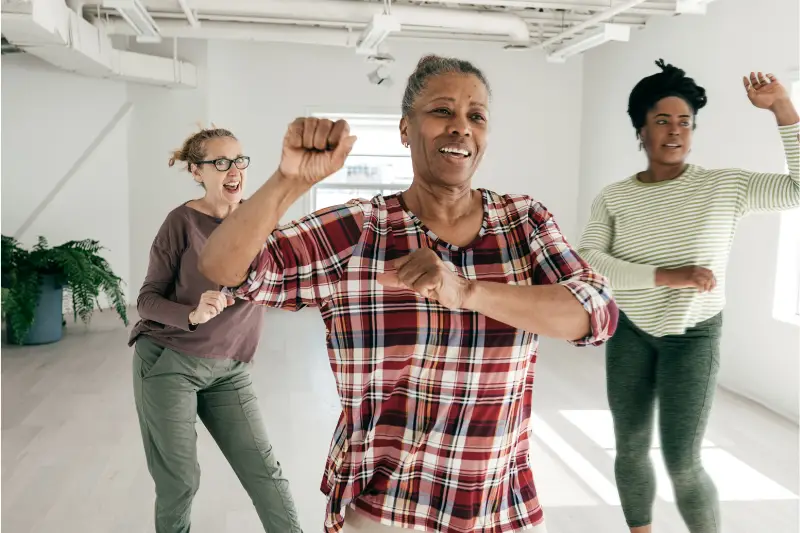If you suffer from joint pain or arthritis, you may find it challenging to maintain your balance.
This can lead to a higher risk of falls, which can cause serious injuries.
Fortunately, there are specific exercises you can do to improve your balance and reduce the risk of falls.
In this article, we will discuss 15 balance exercises for people with joint pain or arthritis.
[ez-toc]

Why is Balance Important for People with Joint Pain or Arthritis?
Balance is essential for people with joint pain or arthritis because it helps them maintain their stability and avoid falls.
Falls can lead to severe injuries, such as broken bones, which can further worsen joint pain and arthritis symptoms.
By improving your balance, you can reduce your risk of falls and enhance your overall well-being.
What are the Best Balance Exercises for People with Joint Pain or Arthritis?
- Standing on One Foot: Stand with your feet hip-width apart and lift one foot off the ground. Hold this position for 30 seconds, then switch to the other foot.
- Heel-to-Toe Walk: Walk in a straight line, placing your heel in front of your other foot’s toes with each step.
- Single-Leg Deadlift: Stand on one leg and lower your body, keeping your back straight and lifting the other leg behind you.
- Yoga Tree Pose: Stand with your feet together and lift one leg to the inside of the opposite thigh, placing your hands together in front of your chest.
- Tai Chi: This ancient Chinese martial art involves slow, flowing movements that can improve balance and reduce stress.
- Chair Stand: Sit in a chair and stand up, then sit back down. Repeat this exercise for several repetitions.
- Side Leg Raise: Stand with your feet hip-width apart and lift one leg to the side, keeping your foot flexed. Lower your leg and repeat on the other side.
- Wall Push-Ups: Stand facing a wall and place your hands on the wall at shoulder height. Slowly lower your body towards the wall, then push back up.
- Mini Squats: Stand with your feet shoulder-width apart and slowly lower your body into a squatting position. Hold this position for a few seconds, then stand back up.
- Step-Ups: Step up onto a step or platform with one foot, then step back down. Repeat with the other foot.
- Calf Raises: Stand with your feet hip-width apart and lift your heels off the ground, then lower them back down.
- Back Leg Raises: Stand with your feet hip-width apart and lift one leg behind you, keeping your knee straight. Lower your leg and repeat on the other side.
- Toe Taps: Stand with your feet hip-width apart and tap your toes on the ground, alternating between each foot.
- Sit-to-Stand: Sit in a chair and stand up, then sit back down. Repeat this exercise for several repetitions.
- Walking: Regular walking can help improve balance and reduce the risk of falls.
How Often Should You Do Balance Exercises?
You should aim to do balance exercises at least three times a week, preferably every day, for best results.
Start with a few exercises and gradually increase the number and intensity of your exercises over time.
How Do You Know If You’re Doing Balance Exercises Correctly?
When doing balance exercises, it’s essential to maintain proper form and technique to avoid injury.
You should always start with the easiest version of an exercise and work your way up to more challenging variations.
If you’re unsure if you’re doing an exercise correctly, consult a physical therapist or trainer.
What Are Some Tips for Safe and Effective Balance Exercises?
Here are some tips to help you get the most out of your balance exercises while avoiding injury:
- Start with simple exercises: If you’re new to balance exercises, start with simple exercises that you feel comfortable with, then gradually increase the difficulty level.
- Use support: Use a chair or a wall to support yourself during exercises if needed. As you progress, you can gradually reduce the amount of support.
- Wear supportive shoes: Wear shoes with good support and traction to help prevent slips and falls.
- Focus on proper form: Pay attention to your posture and technique during exercises to ensure proper form and avoid injury.
- Don’t overdo it: Avoid pushing yourself too hard, especially if you’re new to balance exercises. Listen to your body and take breaks if needed.
- Consult with your doctor or physical therapist: If you have any concerns about your ability to do balance exercises safely, consult with your doctor or physical therapist.
What Are the Benefits of Balance Exercises for People with Joint Pain or Arthritis?
There are numerous benefits to doing balance exercises, including:
- Improved balance and stability
- Reduced risk of falls and related injuries
- Improved overall physical function
- Reduced joint pain and stiffness
- Improved muscle strength and flexibility
- Improved posture and coordination
- Reduced stress and improved mental well-being
Final Thoughts
If you have joint pain or arthritis, maintaining your balance can be a challenge.
However, with the right exercises and proper technique, you can improve your balance, reduce your risk of falls, and enhance your overall well-being.
Remember to start with simple exercises, use support when needed, focus on proper form, and consult with your doctor or physical therapist if you have any concerns.
FAQs
- Can balance exercises cure joint pain or arthritis? No, balance exercises cannot cure joint pain or arthritis, but they can help improve your balance and reduce your risk of falls, which can worsen joint pain and arthritis symptoms.
- Is it safe to do balance exercises if I have severe joint pain or arthritis? It depends on the severity of your condition. If you have concerns about doing balance exercises, consult with your doctor or physical therapist before starting an exercise program.
- How long does it take to see results from doing balance exercises? Results can vary, but you may start to see improvements in your balance and stability within a few weeks of doing regular balance exercises.
- Can I do balance exercises at home without any equipment? Yes, many balance exercises can be done at home without any equipment. However, some exercises may require the use of a chair or wall for support.
- Are there any risks associated with doing balance exercises? Like any form of exercise, there is a risk of injury associated with doing balance exercises. However, by using proper form and technique and starting with simple exercises, you can reduce your risk of injury and get the most out of your exercise program.
